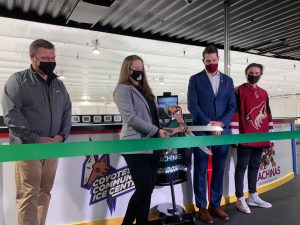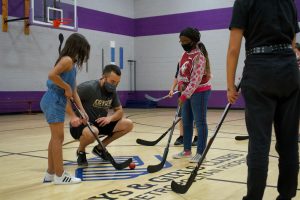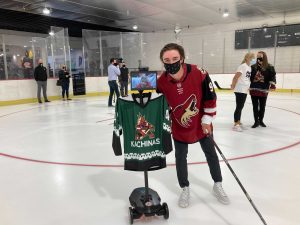- Slug: Sports-Youth Hockey Growth, 1,400 words.
- Photos available.
By Jake Santo and Michael Gutnick
Cronkite News
PHOENIX – From “Rookie of the Year” to “Little Giants,” sports movies captivated kids growing up in the 1990s.
One of those was a young girl from Chandler, who fell in love with an unlikely sport.
Hockey.
For a native of the Valley, hockey seemed as out of place as a cactus in Buffalo. As someone who found her love from the Mighty Ducks film franchise, the fast-paced, bone chilling drama of Coach Gordon Bombay and his group of misfits overcoming the odds resonated with young Lyndsey Fry.
These days, the Olympic silver medalist in women’s hockey is a key figure in the Arizona Coyotes’ movement to increase youth hockey participation in the state, especially in non-traditional markets. With various youth development programs and outreach efforts, the Coyotes are making an impact.
“The youth hockey market and the growth (in Arizona) is phenomenal,” said Coyotes President and CEO Xavier A. Gutierrez, who took the job six months ago and became the first Latino to hold those positions in NHL history. “Every youth hockey fan that you can identify and convert leads to 3.3 more fans.”
The presence of the team has made an impact. Arizona ranks second among all U.S. NHL markets in total growth percentage over the past five years, according to a 2019 study by USA Hockey. In addition, Arizona ranked first in total percentage growth for female hockey players and first for total 8-and-under hockey participation percentage over the past five years.
Fry leads the Coyotes’ female development program, the Arizona Kachinas, which looks to promote female youth participation within the Valley in a welcoming environment, while growing the outreach efforts of the Coyotes statewide. The NHL club is also reaching out to youth in the Hispanic community, part of an overall initiative to connect with that market in Arizona.
Fry and the Arizona Coyotes have been instrumental leaders in growing the game in the Valley. Girls hockey in the state of Arizona has grown 53% over the last five years and 236% in the last decade, according to the Coyotes.
The year before the organization relocated to Arizona from Winnipeg in 1996, just four female players were registered with USA Hockey, the governing body for amateur participation in the sport. In 2019, 779 females were registered in the state, including 91 players ages 6 and under.
Since their arrival, the Coyotes have been proactive in their pursuit of getting more kids involved with hockey in the desert.
Gutierrez wants to continue the trend. Within weeks of taking office, he and his team partnered with Eddie Hill, owner of the Arizona Made Ice Forum, completing the ninth full-time rink in the state with the Coyotes Community Ice Center on October 22nd.
Located on Country Club Drive and First Street in Mesa, the Arizona Kachinas now have a permanent home for the dozen teams practicing and playing home games.
“This is huge for the girls, not just for the girls who are playing hockey now but for the girls who are going to be playing for next 10, 15, 20 years. We’ve never had a home that’s exclusively dedicated to girls hockey,” Fry said. “Before, we were just putting our programs where we could. We were finding whatever ice time we could. Sometimes one program would be across three different rinks.
“To be able to have one core place … to know that we’re here I think is going to be a game changer with getting more girls involved.”
When the Coyotes came to Arizona 24 years ago, a new rink sprouted from the ground in Chandler shortly after. Ever more inspired, Fry, now 28, laced up a pair of skates and took the ice for the first time.
“It was pretty much lights out from there for me,” Fry said. “I started playing at Polar Ice Chandler and I never looked back.”
She overcame the adversity that accompanied competing with boys until high school. Back-and-forth trips to Colorado followed before eventually competing for an Olympic medal with Team USA.
And she wondered how she would utilize her degree from Harvard.
She soon realized she could give girls the spark reminiscent of her childhood days.
“I honestly thought doing something in hockey was a waste of my education, but I came back, ran a couple clinics and saw the impact I could have on kids and give them what so many people gave to me. That’s the best feeling in the world. I’ve never regretted that for a day. To be able to give them this new rink and be a part of the team that brought this all together has been an absolute honor.”
Coyotes forward Clayton Keller joined general manager Bill Armstrong, Fry and Hill at a ribbon-cutting event at Coyotes Community Ice Center, which included shooting ceremonial pucks into a net on the ice.
The 22-year-old winger was reminded of his youth hockey days in St. Louis when a new rink opened up 10 minutes away from his home.
“That was the biggest thing for me growing up,” Keller said. “Back when I started playing, the same thing kind of happened. A new rink opened up and I was just so excited to come play. It’s a huge part, having rinks and having somewhere you can call home.”
On top of building rinks within the Valley, the Coyotes have made their presence felt in hard-to-reach communities.
In honor of Hispanic Heritage month, the Coyotes held a street hockey clinic for kids at Chicanos Por La Causa. Three weeks later, the team replicated the experience at the Boys & Girls Clubs of the Valley in Peoria.
“I guarantee we make Coyotes fans because we were here,” Gutierrez said. “We introduced them to a sport most of them probably had not even known existed. No one had given them that stick and put it in their hand and said, ‘Here you go.’ This could be a part of their personal sports journey.”
Gutierrez remembers his initial spark for the sport, attending a hockey game while studying at Harvard.
“When I walked into that arena, you had 37,000 students playing and watching and getting so animated,” Gutierrez said. “You saw these incredible athletes skating up and down the ice. It was fast. It was furious. That’s what sparked it for me.”
The Coyotes continue to look to the future to grow its ever expanding fan base, appealing to a younger audience born in the state of Arizona. Non-traditional hockey fans are the demographic the Coyotes are seeking to influence most with its outreach efforts.
“It starts with the physical space, then you go to the clubs and the leagues while going to all of the young people who haven’t been exposed to it yet,” Gutierrez said. “First and foremost is how do all of these rinks get tied to us. It’s about building those relationships and becoming deeper and more engaged.”
With the COVID-19 pandemic taking place, the Coyotes have instituted a new program to help kids experience hockey from a home environment. Earlier this fall, the team created the Coyotes Virtual Hockey School. All done remotely via instructional videos, the course helps students learn new hockey skills with daily workouts and institute new mindset goals for students.
An important goal for Gutierrez is to raise more awareness in the Latino community to experience hockey.
The U.S. Census reports that nearly 32 percent of the population in Arizona is Hispanic or Latino. The Coyotes, seeking opportunity, launched three Spanish-language social media accounts in September.
Seven percent of Hispanic men ages 18 to 49 in Phoenix had a Coyotes game in the preceding year, according to the 2015 DATOS report by the Arizona Hispanic Chamber of Commerce. The organization believes that number has increased and it is determined to expose even more Hispanic youth to the game
The breakthrough of Scottsdale native Auston Matthews, an NHL center with Hispanic roots who perfected his game in local rinks around the Valley, serves as a key influence for kids to follow in his footsteps.
“Somebody in this neighborhood is going to become an NHL player, simply by this ice sheet being created,” Armstrong said. “Some family will stroll in that are not hockey people, and the next thing you know, their kid just gravitates to it and the next thing you know there’s an ice hockey player that’s coming from Arizona that’s playing in the National Hockey League.”
For more stories from Cronkite News, visit cronkitenews.azpbs.org.




